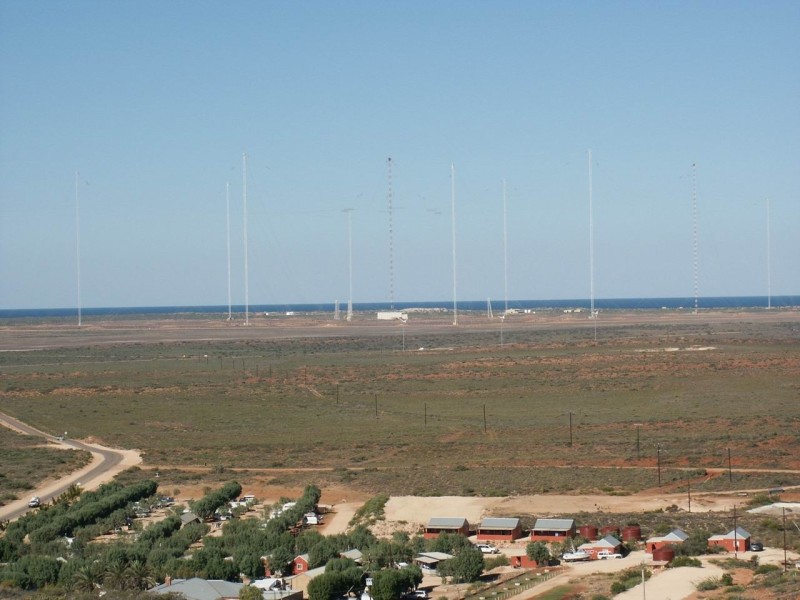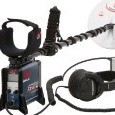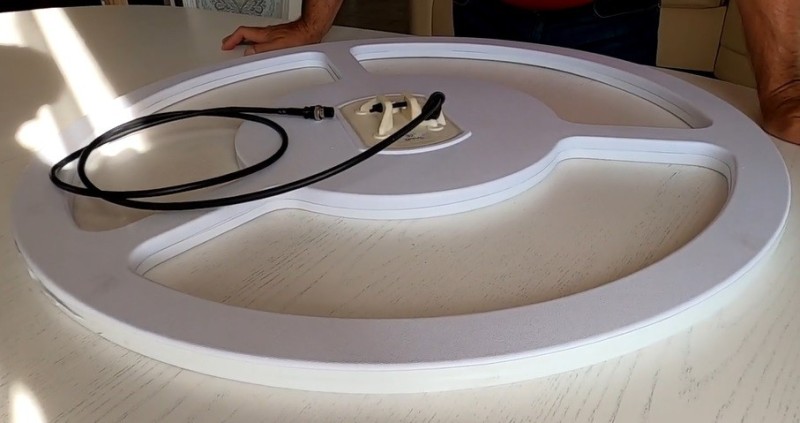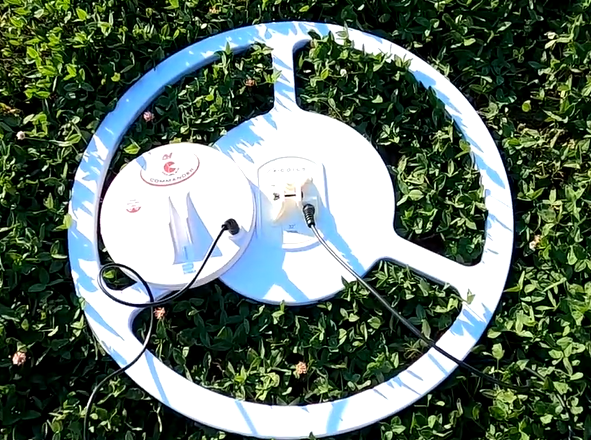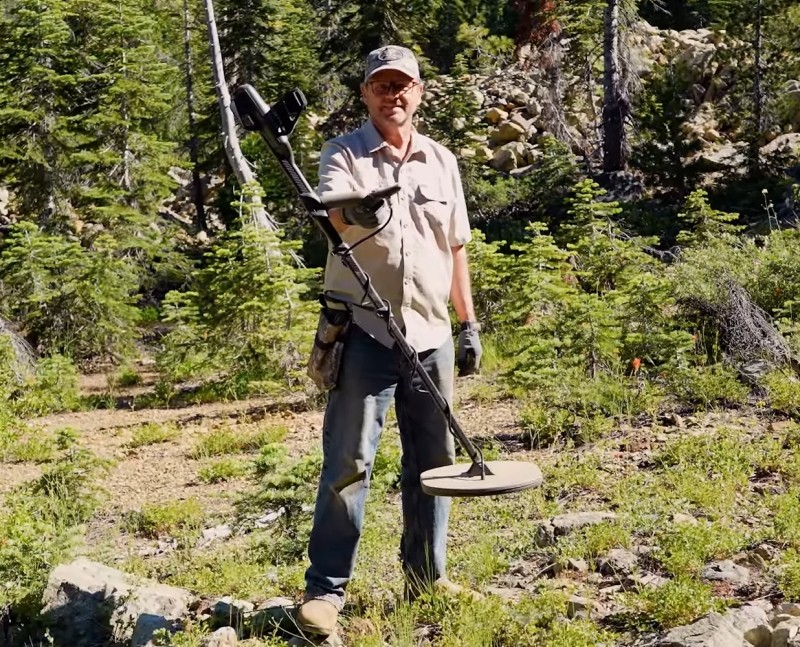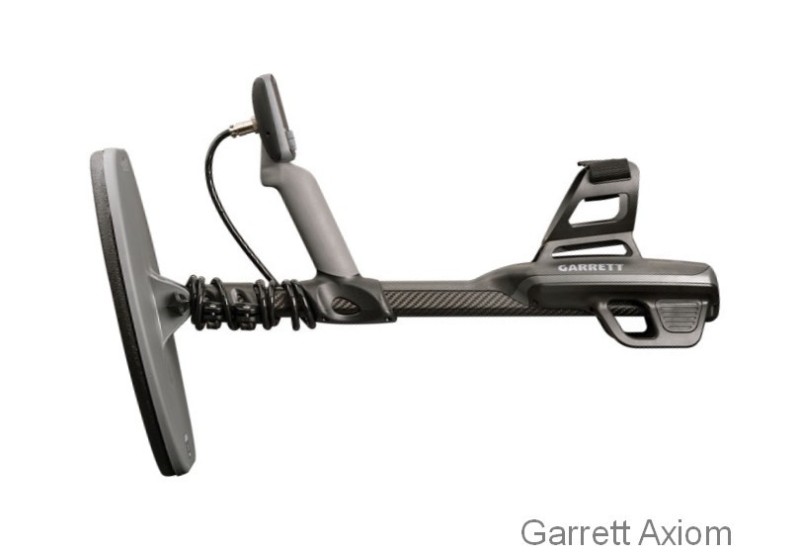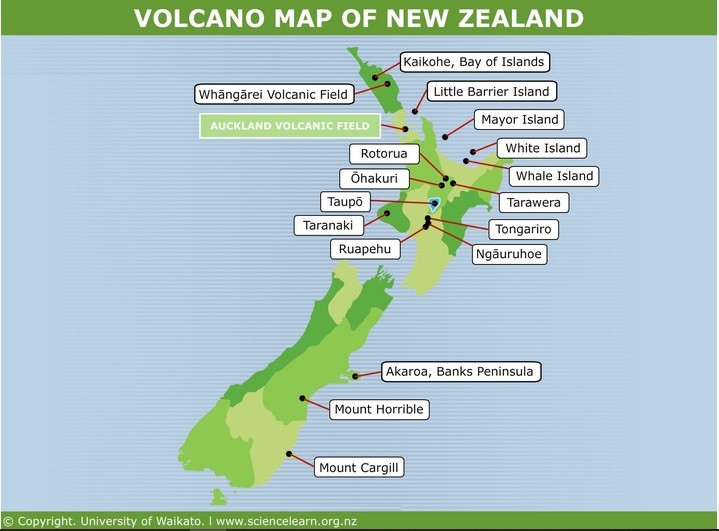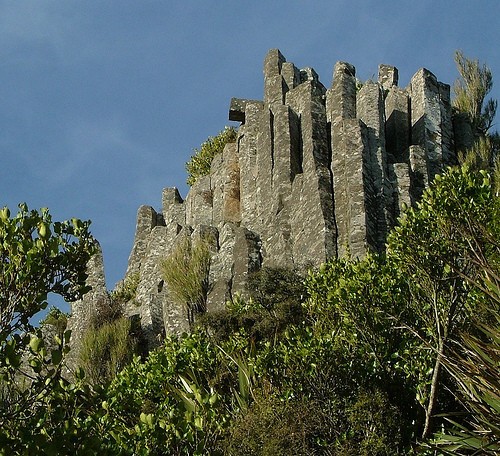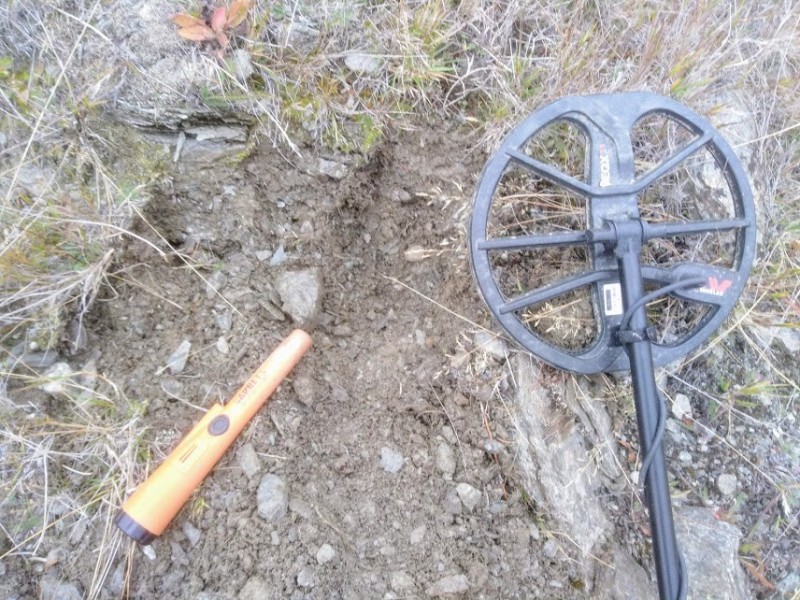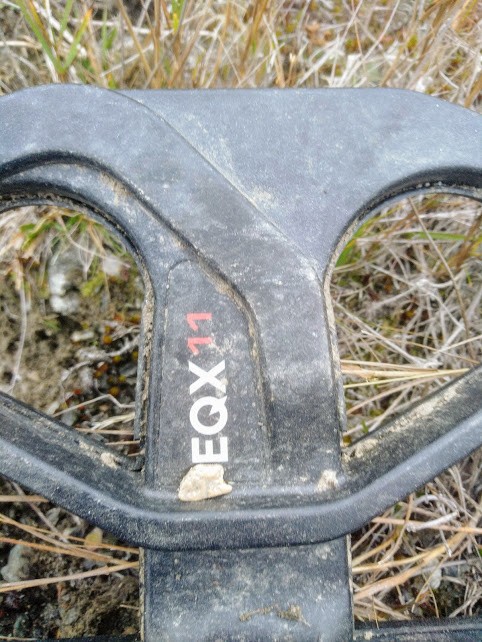Search the Community
Showing results for '"GPX 4500"'.
-
I contacted them about the EMI filter during the height of my GPX 4500 annoyed with EMI days, and the filter is extremely popular in northern Australia due to the radio antennas up that way and that's what the filter does, filters radio waves out, even says so on their website, and the Navy Communication station in northern Western Australia is a big cause of that interference, biggest radio communication station in the Southern Hemisphere so this is where the EMI filter really benefits people. He said for my needs of trying to deal with Power lines EMI it wouldn't overly help much but if any radio waves are in the area and adding to my EMI woes it will help a lot with that and was honest enough to say I probably wouldn't benefit enough to justify buying it. I have done the lithium battery route to mine and like it. I guess on later models like the 6000 and 7000 a similar type of radio wave filter is incorporated into the circuit as few have trouble like they did with the earlier GPX series. These filters have been designed for the current range of Minelab SD, GP and GPX series metal detectors. These filters have been designed and manufactured by Link Technologies in Victoria, Australia. This filter is using the latest state of the art components to remove radio interference and improve the detection of gold. This filter greatly reduces or in most cases eliminates the warble from all radio wave sources of interference. These interference filters are designed to be used with mono type coils. That's really cool, I guess with cell phone towers emitting radio waves it helped with that, and nearby radio stations etc. If I still used my older GPX enough I'd buy one but I'm happy enough with the EMI shield cover and for the worst of EMI the Coiltek AI 11" coil can run right under powerlines and remain stable and be very close to equal performance to the 11" DD Commander. In saying that my GPX has become a coin/beach detector more than a gold detector, I've not even taken my 5000 on a gold hunt, I should do so.
-
I'm not at all surprised with that last video posted where the 18" coil is going deeper than the GPZ with 17x`13" coil on a chunk or iron like that, put a bigger coil on the GPZ and see what happens, even the readily available but nobody wants 19" coil which is similar size. To me rather than modding a 5000 it makes more sense to get bigger coils for the 7000 if you already have one and are chasing big deep targets, the mods are very expensive. The mod I'd want for the 5000 is fixing its massive target holes, that will find more gold. What I don't get, and they've been doing it for a decade is why these handful of independent guys can do mods on detectors to make them better than Minelab could, and if that's the case why isn't Minelab trying to hire them or even doing similar performance improvements to their own detectors. Why is there no GPX 5000 v2 with similar mods included. I'm all for modding stuff, I think it's awesome, but it's a puzzle to me why Minelab doesn't follow the modders which is usually the case. I've had next to no experience with these modded detectors, JW has a modded GPX 4500, never uses it, but has it. He's used it once in my presence and he had a Sadie on it at the time, I had my stock 4500 with the NF 14x9" EVO on it when I first got that coil, I found mine was more sensitive than his on small targets in some very basic tests we did at the time waving over a few pellets. How much of that was the coil I don't know, probably most of it. Neither stood out as being quieter or anything. I don't know enough about the mods done to it to judge it but it was one of the big two that did the mods.
-
Well it looks like at least part of this is coming to pass. At least one reputable MD equipment dealer is announcing the imminent discontinuation of the GPX 5000 (and taking the opportunity to put out a buy 'em while you can pitch). This will be the end of the line for not only for the 5000 but that venerable GPX platform series of prospecting/relic detectors that started with the GPX 4000 in 2006 (which built upon the predecessor GP series). The GPX 6000 is a "GPX" platform PI in name only as far as I'm concerned as none of its accessory components or coils are interchangeable with the legacy GPX 4000/4500/4800/5000 units due to it's updated electronics and form factor. Not surprised they want to mothball the legacy GPX platform at this point. I'm sure it's a drag on manufacturing, repair, and logistics to keep that technologically long-in-the-tooth product line alive (the 4000 was released in 2006, 4500 in 2008, and the 4800/5000 was released in 2010, with the 4800 being discontinued in 2012). The GPX 4500 was discontinued in 2021 so it kind of makes sense the 5000 will reach the end of the line this year.
-
Minelab Fy23 Investor Presentation For 2024 - No GPZ 8000?
phrunt replied to phrunt's topic in Minelab Metal Detectors
The detectors that weed out the last remaining dwindling gold in the ground also face the problem of less customers, the better detectors get in an odd way the less customers are available to sell them to. That's what's happened with Africa.... the easy good gold is gone or going fast, the GPX 4500 and 5000 were extremely popular there, I even own an ex-African GPX 5000, I can only dream of the gold that 5000's found, more so than I'll ever find in my lifetime. The 7000 from what I've been informed wasn't as popular but still a somewhat common detector to see, I would guess due to price or due to the value they see for the price over the 4500 for example, if most of the gold they care about can be found with a 4500 for a much cheaper price why buy a 7000. The 6000 comes out to specifically target that market and falls flat on its face in Africa, it didn't take off like hoped as investor reports have often stated sales are not as good as hoped for the 6000 and now the investor reports are saying we need to move off the African market and focus on expanding into other markets. This can't be due to conflict and so on in parts of Africa, it's a big place with many countries that are heavy gold producers and not all are problematic yet the African sales died. The African market has its problems outside of prospecting that has caused some sales issues but the main reason I think is these people need to make a living off the gold they find, they don't get paid properly for the gold they do find so they need to find even more to make it worthwhile, the bigger easier bits are gone and they don't want to scratch around like chickens plucking out a 0.03 of a gram piece so once the easier gold the 5000 can find is gone so is the gold rush. The Africans didn't get paid per gram the prices we can get if we sell gold, they got a pittance for it, they often had commission to the local rogues that controlled the area too, they sold their gold illegally to middle men that sneaked it out of the country. If they tried to sell it the legal way it's not worth being a small-scale miner, so they went black market but still the price per ounce was small so they had to find a lot of gold to make it worthwhile. Here is a older story on it that's worth reading Gold worth billions is smuggled out of Africa - new analysis (reuters.com) The depth on the bigger deeper gold I believe the 4500 still beats the 6000, it helps with its large range of coils but it can support large coils so depth on big gold is still the 4500 and I'm sure the Africans worked that out quick smart. The funny thing about the 6000 is they intended it to be the good seller in Africa, it turns out its the better seller to other places where the people are trying to scratch out the remaining gold the other detectors missed by its ability to find very small and odd gold that was missed by previous models for various reasons and you see that with people selling the 7000 which is the top of the range to I guess you could say downgrade to the 6000 to find these smaller bits of gold that are left. For us in countries outside of Africa it's been a good success story, more so than Africa but we are a smaller group of people so the revenue wasn't as hoped. -
Down To Three Detectors
phrunt replied to Steve Herschbach's topic in Metal Detector Advice & Comparisons
I can't bring myself to thin my herd, I got rid of the QED but that was out of principal more so than I wanted to get rid of a detector, I also got rid of my GPX 4500 but mainly because a guy I know wanted to detect black sand beaches here and he bought a Tarsacci with their infamous NZ black sand coil they say was made for NZ's black sand beaches and it sucked basically and wasn't suitable and I knew my GPX handled it with the 11" DD so I moved it onto him seeing I have a 5000 anyway and was unlikely to use it again. So instead, I just have gear I use, and gear I collect 😉 And my herd is as follows in order of amount of use Equinox 800 (tops the list as I use for gold and coins) GPZ 7000 CTX 3030 GPX 6000 Garrett 24k Manticore Ace 300i My other detectors are just decorations. And my pinpointers that get used in order of use hours are Garrett AT Sphinx 03 (too new to clock up enough hours) XP-Mi4 Others are just decorations.- 45 replies
-
- dfx vx3 v3i
- minelab equinox
-
(and 1 more)
Tagged with:
-
Nokta Makro Pulse Induction Gold Prospecting Detector
phrunt replied to phrunt's topic in Nokta / Makro Metal Detectors
The Impulse project was severely messed up by releasing a waterproof beach detector prior to the gold detector, it was done the wrong way around, such a small market by comparison. I have no idea how long it takes to make a detector from scratch so I've still got my hopes up Nokta are working away on it in the background and will surprise us. I would say there isn't really room in the market for another PI gold machine, but that's completely wrong. There is plenty of room, it just has to be at the right price, a reasonable price that makes it an affordable detector for many to use. If they make it dual purpose with some features that coin and jewellery, relic and even beach hunters would like and also keep the price low they'll hit a home run. I shouldn't really be advocating for a cheap PI as that means there would likely be more people looking for gold in areas I look, price is what keeps the hobby limited in numbers, not many hobbyists are willing to pay the price and rightly so, unless you're in a very good gold location no matter how many hours you put in it's unlikely you will recover costs so you're doing it for the love, the challenge and that takes the numbers of people willing to do that right down. If Nokta can do it, and do it at the right price they can expect to open up a whole new market of weekend or even holiday/vacation warriors with detectors, I thought Garrett was going to do that but they went for well-trodden high-priced route and have also quite severely limited their sales doing so. I would argue ideally it needs to be a lot better than a TDI, The QED is better than a TDI I hear and it's not quite where this Nokta needs to be to be very enticing, closer to a 4500 or 5000 would be better, anything better than that is pure gravy. If a QED level is all they can do which you would think they can with it being a one-man job from a garage in rural Australia armed with his 3D printer and some electronics skills then it needs to be priced right more towards VLF pricing for what it is then it would still be a good success I think, but to really cause a stir the GPX 4500 should be the goal post. There is little reason a PI should cost a lot more than a VLF, the only real thing costing more is the extra battery power it would require although QED's run off two 18650's -
Should I Sell My GPX 5000 To Get An Axiom?
phrunt replied to Steve Herschbach's topic in Metal Detector Advice & Comparisons
The GPX 4500/5000 from my experience have quite large detection holes, or targets they're weak on even though the size of the nuggets should be well within their reach, I have a number of nuggets sizes that the GPX 4500 and 5000 should love yet they struggle to hit on them, and in some cases miss them entirely. I'm not sure about the Axiom but this is the biggest problem I find with the GPX 4500/5000, switching timings can help in some cases but not all and you're not exactly going to run over areas in all different timings to ensure you got it all, well you could but it's easier just to use another detector without this issue. Later detectors like the GPZ and GPX 6000 hit these same "difficult" nuggets fine, so technology has evolved. -
32" Spiral Coil For The Legacy Gp/gpx Series
Northeast replied to phrunt's topic in Minelab Metal Detectors
32" spiral...mono coil? And you mentioned in the post GPX 4500/5000 and in the heading GP and GPX...it still work on the GP series? Weight will be interesting 👍 -
A couple of years ago X-coils discontinued older legacy model GPX coils, however demand has been large in their part of the world by relic hunters and big deep gold hunters for a large coil, so they come up with the goods with a 32" Spiral wound GPX 4500/5000 coil. It's an absolute monster of a coil, I can't imagine this being sold into the international market due to shipping a coil this size, hopefully the people in Europe can find some good deep relics and gold with this thing. It's good seeing some life brought into older models with all the excitement and talk these days of the newer models.
-
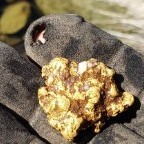
Garrett Axiom Rye Patch Rain And Nuggets
Calmark replied to Calmark's topic in Detector Prospector Forum
It can be tough to get nuggets at Rye Patch any time of year, but when you and I were there, the soggy ground and weather made it even more of a challenge for sure. I'm sorry your group didn't get any gold. I detected over 3 days last summer in June and also got skunked using my ML 6000 in dry ground. I helped two older greenhorn guys with vlf machines who were there set up their machines and scan some signals I found. One had a gpx 4500 he didn't know how to use, so I had him switch that machine and to his 11in mono and set all the proper settings for him. I saw both later in the afternoon, and they had quite a few dug targets, but no gold. We all had a great time camping out and sharing the fun of prospecting and that's what its all about. -
The 12x7 Exceed On The 6000 Is A Beast
phrunt replied to Gold Ryder's topic in Detector Prospector Forum
I also bought the 14x9" as I loved that size on my GPX 4500, I can't say I'm all that impressed by it so I wish I saved my money for the 12x7 in that case. The 12x7 seems an excellent coil, for my needs the 14x9" is a bit of a disappointment really and I'd rather just use the less stable 11" for the better performance. -
I’m on Social Security with a little retirement fund and I work 2 part-time jobs. The last thing I needed was to pay over $4000 US for the GPX 6000. The lighter weight and the high sensitivity to a wide range of nugget sizes is what tempted me to do it. I was disappointed in the GPX 6000 at first but now I guess I am happy with it. Have I found $4000 US worth of gold with it already…..nope. Like many, I tried the less expensive Whites PIs and even had a go with the QED. They just aren’t the answer for me. A GPX 4500 in a lightweight housing with lightweight battery sounds fantastic. I would be just as happy with a PI that costs half as much as the GPX 6000 that would hit 0.1 gram nuggets a few inches deep along with deeper bigger sized gold, that weighs less than 4 lbs, uses current GPX 5000 and prior models Mono and DD coils and would double as a good relic and saltwater beach detector.
-
The idea has never been to produce a cutting edge product, a GPZ 8000, for $2000. Yes, development costs are real, and must be recouped. I have always been thinking GPX 4500, which last sold for $2699. Dealers cried when Minelab discontinued it. Development costs long since recouped. All it needs is to be repacked in a modern housing using a modern battery option. I’d be thrilled with something like that and have never asked for more on this thread. Minelab can do this easily. Minelab discontinued the machine since, as a monopoly, it was undercutting sales of the $3999 GPX 5000. Solution? Discontinue 4500 so you have to buy the 5000. That’s what lack of competition gets you. The 4500 always was and still is Minelabs ace in the hole, that allows them to stop any threat by Nokta dead in its tracks. Maybe Nokta has figured this out? Whatever, we will get there, and not too much longer. The fire of competition is doing its magic in VLF as I type. A match has been lit to PI and people like me will continue to fan the flame until somebody fills this massive hole in the detecting market.
-
Under 4 Pound, Under $2000 Gbpi Challenge
phrunt replied to Steve Herschbach's topic in Metal Detector Advice & Comparisons
Steve makes a good point about the 4500, they could repackage that and head off any competition at the pass a bit like the X-Terra coming in to make the new Simplex rehashes redundant. If they ever made a lightweight GPX 4500 in a modern new housing it would be a great seller if it was at the right price. They could even trim the 4500's features down a bit seeing it's so close to the 5000 and come in at a really good price. I'm sure there are people at Minelab that's job is just this, trying to stay ahead of the competition in all areas. I don't care who does it will benefit greatly from doing so, especially if it appeals to more than just the gold market. -
I’m somewhat amazed that over six years after I issued this challenge, nobody has won the prize. If anything, we have gone backwards, since the White’s TDI took away a model that met the criteria but unfortunately lacked the horsepower. Among major manufacturers that leaves us with the new Garrett Axiom as being as close as we get. I’ll give them a win on the weight at a perfectly balanced 4.2 lbs. The SDC 2300 is currently the only other option, better on price, but horrible ergonomics. This is where we are in 2023 as far as the challenge and the major producers: Fisher - no ground balancing PI being offered Garrett Axiom 4.2 lbs $3995 Minelab SDC 2300 5.7 lbs $3399 Nokta - no ground balancing PI being offered XP - no ground balancing PI being offered Axiom weight is good but price is still twice my targeted US$2000. It is therefore still an open challenge with only Fisher and Nokta in the running at this time. The Impulse Gold might get announced by the end of this year if we are lucky, and never if we are not. And we have no idea what the price will be. If the ergonomics match the Impulse AQ we will have a winner in that regard, but I’m worried Fisher will look at the Axiom and SDC price and come in at like $2995 just because they think they can. That would be a move in the right direction, but still too high. They are still selling the prototype Impulse AQ at $1700 though, so there is hope. That leaves Nokta, but not a peep out of them on the subject since just over a year ago, when the detector was only in the pencil to paper planning stage. A year is not long enough to get a new detector done when starting from scratch, but maybe it’s possible by 2024. Or does Minelab pull a “Xterra Pro” and head off everyone with a repackaged GPX 4500 for MSRP $2495 with an out the door price near $2000 ? It could happen, and Fisher and Nokta better get with the program or see this opportunity fade away. Me, I don’t care who does it, as long as it gets done. Until then I’ll use the Axiom as being as close as we can get at this time. It’s my way of supporting those who make progress to this under 4lb under $2K goal, and if anyone gets even closer I’ll look hard at using what they come up with instead. It merely need be as good as the Axiom, but at a lower price. Garrett met my minimum power needs, met the ergonomic challenge, but I’m disappointed at the price. That alone is keeping Garrett from selling the Axiom by the truck load. Garrett Axiom, 4.2 lbs, $3995
-

Axiom Not Detecting Test Piece
Steve Herschbach replied to Dain Blackburn's topic in Detector Prospector Forum
I do not know of any extensive comparison tests done between the Axiom and GPX 4500 so there is also a not zero possibility the 4500 can detect that nugget better. Please do report back on what Garrett’s findings are with the machine. I’m less than thrilled so far by the reports of defective units. Yeah, Minelab really dropped the ball with the GPX 6000 in that regard. But so far I’m not impressed with the failures I’ve heard about from Garrett owners either. Can’t anyone make things correctly anymore, and more importantly, do proper quality control before units are shipped? -

Axiom Not Detecting Test Piece
Steve Herschbach replied to Dain Blackburn's topic in Detector Prospector Forum
You don't mention the nugget size so hard to say. The Axiom will hit gold down to 0.03 gram in the field, with 0.06 gram and larger being common finds. The smallest bits will only signal on the edges with the mono coils (this is normal with all mono coils on all brands), with each of the four corners being the hottest spots. So when you say heel of coil only, well, it should not be heal only, but on the tiny bits maybe more like edges or four corners only. As nuggets get larger the signal will pull away from the edges and go to the center. The Focused Core DD coils are hottest in the center of the coil. Unless you are comparing directly to a GPX 4500 its memory only at work. Nuggets vary greatly in how well they can be detected due to purity, shape and orientation, and porosity created by air spaces or rock inclusions. I agree however with Gerry that an Axiom in general will hit as well or better than a GPX 4500 on small gold. But again, on solid relatively pure bits, 0.06 gram and larger should be easy finds, with experts getting down to 0.03 gram surface bits. The nuggets below were found by several different operators using the Axiom in Australia and are in the range I am describing. My own personal commentary to the casual inquirer would be to expect to be able to find nuggets down to 0.05 gram. You'll have to be on top of your game to be hitting gold smaller than that. A smaller mono coil would be welcome in helping with that, something like the 6x8 Sadie would be fabulous, but so far no aftermarket coils have appeared. -
I do find it tracks out really tiny bits, but you can get them back again with a ground balance or even swinging off to the side of your dig for a bit but they're probably a bit smaller than your gold Dave I think our hot rocks are basaltt? Well I've been told they likely are by images of them but the 6000 has a lot of trouble with those particular ones, the GPZ had trouble with some green hot rocks we have too. Both are highly magnetic. We do have a few volcanoes dotted around though that according to my research threw out a lot of basalt. The best for me and hot rocks has been the GPX 4500 and 5000. The two closest to me are extinct now, the North Island is home to all the active ones and lots of them, the ones closest to me threw out a lot of basalt and surrounding them is filled with it. They even have Taupo supervolcano that is twice the size of Yellowstone so if that ever blows.... White Island is the one that blew up two years ago killing a heap of tourists that were checking it out. 😞 This is a basalt outcrop they call the organ pipes at the Volcano nearest to me. Pretty cool how the lava formed like this. My soils maybe often pretty mild but hot rocks are my issue.
-
I guess what could explain what you're seeing is if with the 17' coil being larger they didn't need to do the semi spiral windings and were able to lay them out completely flat now as a full spiral coil not in layers on top of each other like the 11". This would likely give the sensitivity increase that you're experiencing that allows it to somewhat keep up with the 11" coil. I've run a lot of coils on my GPZ and older model GPX both bundle and spiral (flat wound) in a variety of different sizes, often the exact same coil size with different windings to see the real world differences between a coil being bundle and spiral and I'm sure many owners with an older model GPX have run say a 14x9" mono bundle coil and then a 14x9" mono spiral coil and seen first hand the extra sensitivity the spiral coil gives them. I first run a semi spiral coil like the GPX 6000 has on my GPX 4500 when X-coils released the 12x6" coil for it which was their first Semi spiral coil as spiral windings wouldn't fit and they wanted a coil more sensitive than bundle windings so they made the 12x6" Semi spiral for the GPX 4500/5000, the same winding design was later used in the GPX 6000 coils. We need @strick with his super-dooper X-Ray machine to X-ray the 17" coil to really get the answers. 🙂 It would explain the almost comparable sensitivity levels you're talking about. I haven't seen the two coils having similar performance on small gold here in my brief encounter with the 17" seeing it miss targets that were easy for the 11" but my grounds very different. I haven't seen JW use that coil since that day. The detectors not hindered by soil in my mild soils so much so I guess in optimal conditions the 11" can shine over the 17", weaken the more sensitive performance of the 11" with some bad soil and whatever Geosense does because of this and perhaps the gap in performance is less noticeable. The more sensitive a coil the more it needs wound back in difficult ground to work optimally. Much like the 14x9" Coiltek coil, I find that very weak on small gold compared to the 11" and 10x5" coil. Some in Australia have said it's almost the same.... I could not disagree more so much so I never use it and may end up using it as a "sacrificial coil" to get its chip out..
-
Who Has Had Issues With Their Gpx 6000?
phrunt replied to Goldseeker5000's topic in Detector Prospector Forum
Too true, I don't ever use my GPZ Minelab coils, both my 19" and 14" coils are basically new just used them to test if I wanted to use them, My GPX 4500/5000 Minelab coils are still basically brand new and as found out quickly I didn't want to use them 🙂 My 6000 coils are now closet queens, except the DD as I need it for it's EMI handling sometimes, If I had an option to buy my detectors with no coils I'd certainly do it. -
This is a good Q&A on the GPX 6000 for those considering one, Nenad was a field tester for it and knows what he's talking about. I found what he has said in his Q&A here very agreeable. https://phasetechnical.com.au/minelab-gpx6000-gold-detector-qa/ I like that he makes the case for the various detectors and honestly talks about their strong and weak points. Now the GPX has it's known issues resolved it really is a good detector and I really like mine, as is the GPX 4500/5000 he also talks about and of course the GPZ 7000 is great, and in my mind the best there is.
-
Yea, it's a fair bit different here, someone can only have a VLF and still do quite well. It may not look it from the hole in the photo but the nugget was down just over the depth of the Carrot. I was using the Nox in this spot with the 11" coil to cover ground well and using it to block out hot rocks as the GPX 4500 I also had at the time was really struggling with them, or I should say I was really struggling to use the GPX because of all the hot rocks 🙂 I did quite well this day and got a few, the previous couple of visits to the spot with the 4500 I was skunked and spent my days digging hot rocks. In hindsight I should have tried a DD coil on it rather than the 14x9" EVO I was using. I haven't even had my GPZ there, nor my 24k or Manticore obviously. Might have to go again soon before too much snow hits. 1.2 grams.
-
Gold Detector
RONS DETECTORS MINELAB replied to Karl48's topic in Metal Detector Advice & Comparisons
Lots of people are selling their older model detectors for the newer models coming out. I guess it’s like having packrat syndrome, must have the shiny and new. This opens up a good opportunity to get some good detector prices for people on a budget. As a dealer and trainer I get asked a very good question by a lot of customers on what prospecting detector would be best for them. My answer is usually what is your price range and how mineralized is the area you planning on prospecting? How much rubbish is in the area your detecting? If they are new to prospecting and not sure where to even go, I recommend them doing some research on the mining districts closest to them. My usual recommendation for their best chance of finding nuggets is to get a PI detector when in medium to heavy mineralized ground or a VLF with a very good target VDI for low mineralized ground in rubbish littered areas. Usually the PI detectors exceeds there price limit. There are options for used PI detectors at VLF pricing, but this comes with risk by not having any warranty. I recommend only keeping a detector that’s under warranty due to the high price of repairs, but do understand there are some really good prices on used detectors also, such as the GPX-5000. The following list is just a recommendation from my experience using a majority of these detectors on what will work for nugget hunting. I am not saying price always determines the best performance due to many variables in metal detecting. This is not a debate on detector performances as it is more about what price to expect to pay to get into this hobby. All the VLF’s listed here can or should pass the bic pen sensitivity test. There are many more comparable models out there, but these were probably some of the lower priced prospecting detectors I have found for the money. Just a few Detectors for light mineralization and a low price where a VLF can work well: $289,00 Minelab X-Terra Pro 3 year warranty. Has ground balance. I recommend nugget hunting in Park 2 15Khz mode for best sensitivity. Also a multi-purpose detector. Great price and also can use Equinox coils. Fisher Gold Bug newer Digital w 5 inch coil 19Khz. 5 year warranty. Fisher F19 w 6 x 10 inch coil package. 19Khz 5 year warranty. Nokta Legend Pro Pack w 6 inch coil package Multi Freq. 3 year warranty. Also a multi-purpose detector. Nokta/Makro Gold Kruzer w 4 x 7.5 and 5.5 x 10 inch coil package 61Khz. 3 year warranty. Garrett 24K w 6 x 10 inch coil 48Khz. 2 year warranty. Fisher Gold Bug 2 analog or digital w 3 x 6.5 inch coil 71Khz. 5 year warranty. This detector is probably a specialty detector with the most sensitivity for cleaning up the smallest leftover nuggets. If you need more sensitivity then the GB2 then probably recommend the Gold Falcon MD20 pin-pointer 300Khz. Minelab Equinox 800 w 6 inch coil Multi Freq. 3 year warranty. Also a multi-purpose detector. Very versatile. Many other used VLF models can come in well under $500.00, but with no warranty probably better to buy a new model for the price difference. For medium to heavy mineralization, a PI is really necessary to have the best success: Weight is usually the downside to PI detectors until the last few new releases. So weight is included on the PI list. Expensive Options! A used GP 3500 can be found for less than $1,400, ATX for less than $1,500, GPX 4500 for less than $1,700, and GPX 5000 for less than $2,000. Most likely non warranty, but these older PI’s were built pretty solid. Maybe others can describe the best options for your areas mineralization though.

